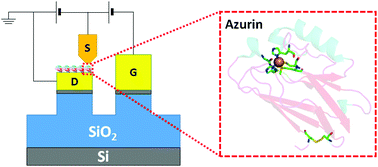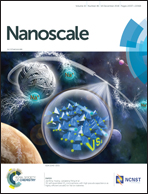Transistor configuration yields energy level control in protein-based junctions†
Abstract
The incorporation of proteins as functional components in electronic junctions has received much interest recently due to their diverse bio-chemical and physical properties. However, information regarding the energies of the frontier orbitals involved in their electron transport (ETp) has remained elusive. Here we employ a new method to quantitatively determine the energy position of the molecular orbital, nearest to the Fermi level (EF) of the electrode, in the electron transfer protein Azurin. The importance of the Cu(II) redox center of Azurin is demonstrated by measuring gate-controlled conductance switching which is absent if Azurin's copper ions are removed. Comparing different electrode materials, a higher conductance and a lower gate-induced current onset is observed for the material with smaller work function, indicating that ETp via Azurin is LUMO-mediated. We use the difference in work function to calibrate the difference in gate-induced current onset for the two electrode materials, to a specific energy level shift and find that ETp via Azurin is near resonance. Our results provide a basis for mapping and studying the role of energy level positions in (bio)molecular junctions.



 Please wait while we load your content...
Please wait while we load your content...